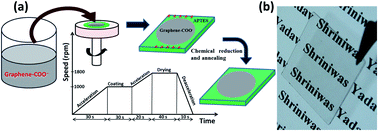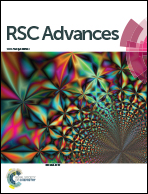Low temperature processed graphene thin film transparent electrodes for supercapacitor applications†
Abstract
The highest conductivity in graphene oxide based thin film electrodes has been achieved using high temperature annealing at 1100 °C. This is unfavorable for low cost production and application over plastic substrates. Here we report highly conducting graphene thin films using spin coating of a functionalized graphene solution over various substrates. The bridged graphene nanoflakes provide higher conducting pathways in the thin film, enabling electrodes to be fabricated at low temperatures of the order 150 °C. These thin film electrodes show remarkable sheet resistance of the order 0.4 kΩ sq.−1 and transmittance up to 94%. This work demonstrates that graphene based transparent electrodes have the potential to replace existing doped metal oxide based electrodes. The electrochemical performance of graphene thin films as active supercapacitor electrodes was evaluated using cyclic voltammetry. The calculated specific capacitance was found to be ≈49, 48, 48 and 68 F g−1 for the graphene thin film electrodes fabricated at spin speeds of 1000, 1200, 1400 and 1600 rpm, respectively. The above electrochemical performance indicates that the graphene electrodes show large specific capacitance and could be very attractive for several applications including wearable electronics, smart windows and advanced display panels.


 Please wait while we load your content...
Please wait while we load your content...